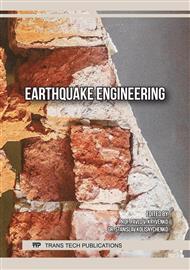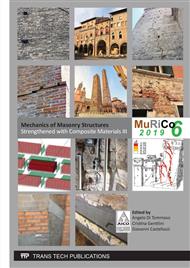[1]
D. Dubină (ed.), Seismic retrofitting of existing structures using steel-based solutions, International workshop organised within the framework of FRS2-CT-2014-00022 STEELEARTH, Timişoara, Romȃnia, 23th November (2015).
Google Scholar
[2]
Information on http://www.tekpeengineers.com/seismic-retrofit.html.
Google Scholar
[3]
Boscato G., Russo S., Dissipative capacity of a FRP spatial pultruded structure. Compos. Struct. 113 (2014) 339-353.
DOI: 10.1016/j.compstruct.2014.03.036
Google Scholar
[4]
S. Russo, Performance of a PFRP structure covering a historic building struck by an earthquake, Adv. Compos. Constr. (2011) – Proc. of ACIC 2011, Coventry, UK, 6–8th Sept (2011).
Google Scholar
[5]
G. Boscato, A. Dal Cin, G. Riva, S. Russo, F. Sciarretta, Knowledge of the construction technique of the multiple leaf masonry façades of Palazzo Ducale in Venice with ND and MD tests, Adv. Mat. Res. 919-921 (2014) – Proc. of ICSBM, Guangzhou, China; 15-16th March, 318-324.
DOI: 10.4028/www.scientific.net/amr.919-921.318
Google Scholar
[6]
G. Boscato et al., Approach and methodology in understanding the structural behaviour of historic arch bridges through dynamic monitoring: The case of Rialto bridge in Venice. In: Large Structures and Infrastructures for Environmentally Constrained and Urbanised Areas – 34th International IABSE Symposium, Venice, Italy, 22-24th September (2010).
DOI: 10.2749/222137810796064174
Google Scholar
[7]
S. Sugano, State-of-the-art in techniques for rehabilitation of buildings, in: 11th WCEE - World Conference on Earthquake Engineering, Acapulco, Mexico, 23-28th June 1996, paper n° 2175.
Google Scholar
[8]
W. McGinley, Design of anchor bolts in masonry, Prog. Struct. Engng. Mater. 8 (2006) 155-64.
DOI: 10.1002/pse.222
Google Scholar
[9]
R. Muñoz, P.B. Lourenço, S. Moreira, Experimental results on mechanical behaviour of metal anchors in historic stone masonry, Constr. Buil. Mater. 163 (2018) 643-655.
DOI: 10.1016/j.conbuildmat.2017.12.090
Google Scholar
[10]
Brick Industry Association, Anchor bolts for brick masonry, Technical note n° 44, (1986).
Google Scholar
[11]
M. Nehdi, A. El Damatty, R. Rahimi, Investigation on lap-joint behaviour of GFRP plates bonded to silica fume and rice husk ash concrete. Int. J. Adh. Adhes. 23 (2003) 323-333.
DOI: 10.1016/s0143-7496(03)00050-2
Google Scholar
[12]
Si Larbi, E. Ferrier, B. Jurkiewiez, P. Hamelin, Static behaviour of steel concrete beam connected by bonding. Engrg. Struct. 29 (2007) 1034-1042.
DOI: 10.1016/j.engstruct.2006.06.015
Google Scholar
[13]
Eurocode 8-3/2003, Design of structures for earthquake resistance. Part 3: strengthening and repair of buildings. CEN – European Committee for Standardization, (2003).
Google Scholar
[14]
EN 845-1:2013+A1:2016, Specification for ancillary components for masonry Part 1: Wall ties, tension straps, hangers and brackets, last edited (2016).
DOI: 10.3403/30265757
Google Scholar
[15]
Masonry Standards Joint Committee (MSJC), Building code requirements for masonry structures (ACI 530-02/ASCE 5-02/TMS 402-02), The Masonry Society, USA, (2005).
DOI: 10.14359/1541
Google Scholar
[16]
Cecchi, S. Russo, F. Sciarretta, Preliminary investigation on FRP profiles for the structural retrofit of masonry structures, Key Engrg. Mat. 747 (2017) – Proceedings of MuRiCo5, Bologna, Italy; 28-30th June 2017, 77-84.
DOI: 10.4028/www.scientific.net/kem.747.77
Google Scholar
[17]
F. Sciarretta, S. Russo, FE modelling and experimental investigation on adhesive joints between clay brick and pultruded FRP profiles. Submitted paper (2019).
DOI: 10.1016/j.conbuildmat.2019.07.291
Google Scholar
[18]
S. Russo, F. Sciarretta, Experimental and theoretical investigation on masonry after high temperature exposure, Exp. Mech. 52 (2012) 341-359.
DOI: 10.1007/s11340-011-9493-0
Google Scholar
[19]
ASTM C67-05, Standard test methods for sampling and testing brick and structural clay tile, (2005).
Google Scholar



